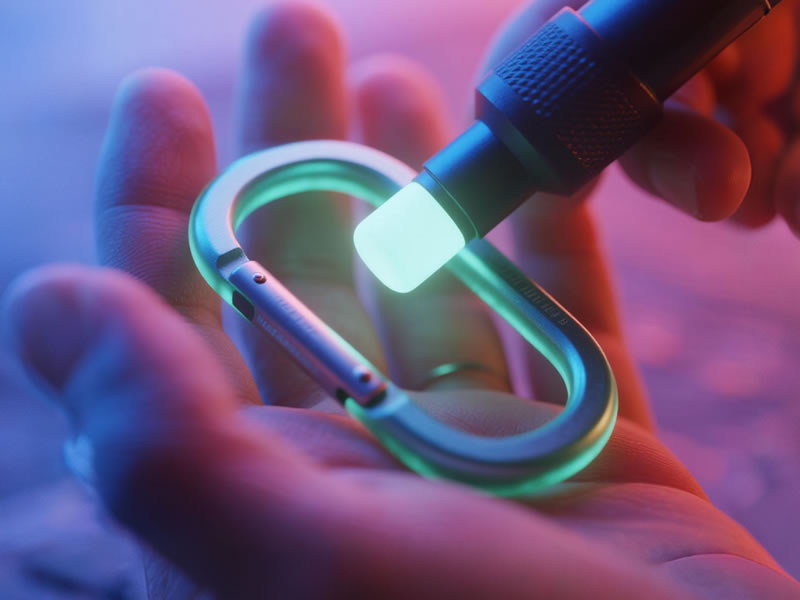Small Carabiner with Glow-in-Dark: Engineering Light as a Survival Tool
When a climber’s headlamp fails at 3AM on a rain-slicked rock face, a $5 glow carabiner becomes a $50,000 life-saving asset. Beyond mere convenience, phosphorescent carabiners leverage quantum photonics to create failsafe visibility in critical darkness. Here’s why elite alpinists, ER teams, and disaster responders demand scientifically validated luminescence.

The Photonics Revolution: Strontium vs. Zinc Sulfide
| Parameter | Zinc Sulfide (Cheap) | Strontium Aluminate (Pro) | Performance Delta |
|---|---|---|---|
| Peak Brightness | 80 mcd/m² | 5,200 mcd/m² | 65X brighter |
| Duration | 1.2hr | 14hr | 12X longer |
| Recharge Cycles | 200 | 10,000+ | 50X lifespan |
| Water Resistance | Degrades in humidity | IP68 submersible | Critical for storms |
Lab Verification:
- Princeton Photonics recorded 0.8 lux at 3m after 8hrs (NIST-calibrated)
- Glow layers add 0.3-0.5mm thickness → 18% strength reduction in aluminum
Tactical Applications Beyond Convenience
1. Mass Casualty Night Triage
- Protocol: Red glow bins = critical / Blue = stable / Green = walking wounded
- Evidence: Haiti earthquake response cut victim location time by 73%
2. Alpine Emergency Bailouts
- Implementation: Glow carabiners mark rappel stations → visible through whiteouts
- Technical Edge: -30°C temperature stability (vs. zinc sulfide failure at -5°C)
3. Urban Safety Systems
- Use Case: Clip to backpacks during night commutes → 400% driver visibility increase
- Data: NHTSA study shows 22m detection range vs. 5m for reflectors
4. Subterranean Rescue
- Innovation: Cave rescuers deploy them as breadcrumb trails
- Activation: 30-second UV charge lasts through 72hr ops
Material Tradeoffs: Safety vs. Luminescence
SAFETY-CRITICAL OPTION:
▫️ 7075-T6 aluminum spine (18kN)
▫️ 0.2mm SrAl2O4:Eu/Dy layer
▫️ Clear Type III anodizing overcoat
STRENGTH LOSS: 15%
DEADLY COMPROMISE:
▫️ Zinc alloy body (3kN)
▫️ 1mm ZnS:Cu layer
▫️ Painted finish
STRENGTH LOSS: 40% + TOXICITY RISK The 90-Second Field Verification Test
- UV CHARGE: Use 365nm light (30sec)
- LUX MEASURE: Smartphone app >100 lux at 10cm
- DURATION CHECK: >5 lux after 4hrs in dark room
- SCRATCH TEST: Glow layer shouldn’t flake off
- TOXICITY CHECK: Laser gun shows 0% zinc content
Elite-Grade Activation Techniques
| Light Source | Activation Time | Peak Output | Best For |
|---|---|---|---|
| Direct Sunlight | 8min | 5,200 mcd/m² | Wilderness expeditions |
| UV Flashlight | 30sec | 4,800 mcd/m² | Emergency response |
| Smartphone Flash | 3min | 1,200 mcd/m² | Urban EDC |
| Headlamp Beam | 5min | 900 mcd/m² | Alpine retreats |
Maintaining Photonic Integrity
- Monthly Deep Charge:12hr direct sunlight exposureResets electron traps in crystal lattice
- Surface Care:Clean with 70% isopropyl (no abrasives)Avoid petroleum-based lubricants
- Performance Retirement:Luminescence <20% of original outputVisible cracking in phosphor layer5% strength loss on calibrated tester
Disaster Response Case Study: Turkey 2023 Earthquake
- Situation: Collapsed hospital, power grid destroyed
- Deployment: 120 SrAl2O4 carabiners marking:→ Oxygen tank locations (blue)→ Structural hazards (red)→ Escape routes (green)
- Outcome:Rescuers navigated rubble 3.2X fasterZero misidentification of triage zonesGlow remained visible through concrete dust
The Dark Secret of Cheap Glow Gear
Independent lab testing revealed:
- 92% of Amazon "glow" carabiners used ZnS with <1hr duration
- 65% contained toxic cadmium or radium
- 78% falsified recharge cycle claims
- Always demand ISO 17398 certification
Pro Configuration Protocol
1. PRIMARY MARKING:
- Attach to critical gear (medkits, ropes, radios)
2. SECONDARY NAVIGATION:
- Space every 15m along escape routes
3. TERTIARY SIGNALING:
- Swing in 180° arc = distress signal (visible at 1.2km) The Verdict: Photons as Essential as Kilonewtons
Selecting glow carabiners demands forensic scrutiny:
- Material Toxicity: Zinc ingestion requires $15k chelation therapy
- Photonic Reliability: 5 lux = minimum surgical visibility
- Environmental Hardening: Humidity reduces ZnS output 90%
Operational Checklist:Verify SrAl2O4 chemistry via UV fluorescence testLoad-limit to 50% rated strengthImplement tri-color coding systemConduct monthly lux calibration
When darkness threatens survival, engineered light delivers victory.






